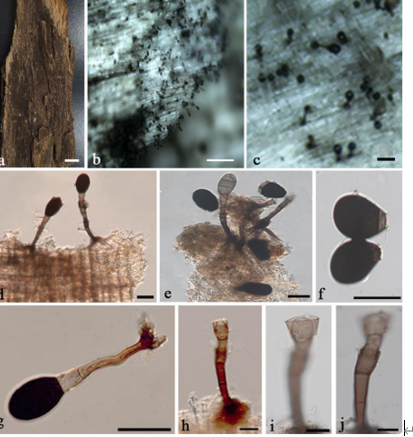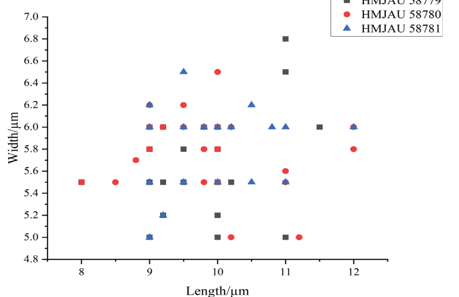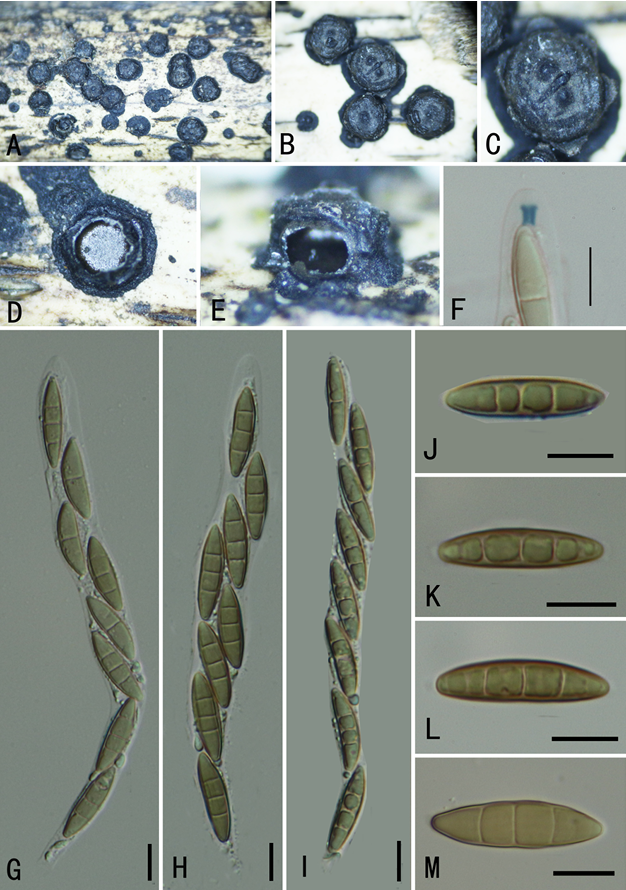Foraminispora yinggelingensis Y.F. Sun & B.K. Cui, sp. nov. 2020
MycoBank MB828434
Holotype: China, Hainan Province, Baisha County, Yinggeling Nature Reserve, on ground of angiosperm forest, 17 Nov. 2015, B.K. Cui, Cui 13618 (BJFC).
Morphological description
Basidiomata annual, centrally stipitate, woody hard. Pileus single, suborbicular to umbelliform, up to 7 cm diam and 4 mm thick. Pileal surface yellowish brown to ferruginous when dry, dull, tomentose, with obvious concentric dark zones and radial wrinkles, slightly sagging at the centre; margin obtuse, entire, flat or incurved and wavy when dry, extending to pore surface. Pore surface white when fresh, colour unchanging when bruised, pale yellow when dry; pores subcircular to angular or irregular, 5–7 per mm; dissepiments slightly thick, entire. Context pale buff, without dark resinous lines, hard corky, up to 2 mm thick. Tubes straw colour, woody hard, up to 2 mm long. Stipe concolorous with pileal surface, cylindrical and hollow, up to 6 cm long and 6 mm diam. Hyphal system trimitic; generative hyphae with clamp connections, all hyphae IKI–, CB+; tissues darkening in KOH. Generative hyphae in context colourless, thin-walled, 2–3 μm diam; skeletal hyphae in context colourless to pale yellow, thick-walled with a wide to narrow lumen or subsolid, arboriform branched and flexuous, 3–5 μm diam; binding hyphae in context colourless, subsolid, branched and flexuous, up to 3 μm diam. Generative hyphae in tubes colourless, thin-walled, 2–3 μm diam; skeletal hyphae in tubes colourless to pale yellow, thick-walled with a wide to narrow lumen or subsolid, arboriform branched and flexuous, 2–4 μm diam; binding hyphae in tubes colourless, subsolid, branched and flexuous, 1–2 μm diam. Pileal cover composed of clamped generative hyphae, thin- to thick-walled, apical cells clavate, faintly slanting to one side and tortuous, bright yellow, about 50–80 × 5–12 μm, forming an irregular palisade. Cystidia or cystidioles absent. Basidia barrelshaped to clavate, colourless, thin-walled, 16–21 × 11–13 μm; basidioles in shape similar to basidia, colourless, thin-walled, 11–15 × 5–11 μm. Basidiospores globose to subglobose, pale yellow, slightly dextrinoid, CB+, with double and distinctly thick walls, exospore wall smooth, endospore wall with conspicuous spinules, (7–)7.2–8.5(–8.7) × 6.6–8 μm, L = 7.89 μm, W = 7.17 μm, Q = 1.1 (n = 60/1). Under SEM, exospore wall uneven or foveolate, endospore wall with some hollow and columnar spinules which persist to exospore wall forming holes.
Habitat: on ground of angiosperm forest
Distribution: Hainan Province, China.
GenBank Accession: ITS MK119821a; nLSU MK119900a; RPB2 MK121536a; TEF MK121570a
Notes: Foraminispora yinggelingensis was collected from the tropical part of China. It is similar to Fo. austrosinensis in the umbelliform basidiomata, white to cream context and pore surface, and similar basidiospores, but the woody hard basidio mata, the absence of cystidioles and the slightly dextrinoid basidiospores of Fo. yinggelingensis make it different from Fo. austrosinensis. In phylogenetic analyses, these two species nested in two well-supported lineages (Fig. 1, 2).
Reference: Y.-F. Sun1,2, D.H. Costa-Rezende3, J.-H. Xing1 et al.

Basidiomata and microscopic structures of Foraminispora yinggelingensis (Cui 13618). a. Basidiomata; b. pores; c. apical cells from pileal cover; d. basidiospores; e. basidia; f. basidioles; g. skeletal hyphae from tubes; h. skeletal and binding hyphae from context. — Scale bars: a = 2.5 cm; b = 0.5 mm; c, e–h = 10 µm; d = 7 µm.









